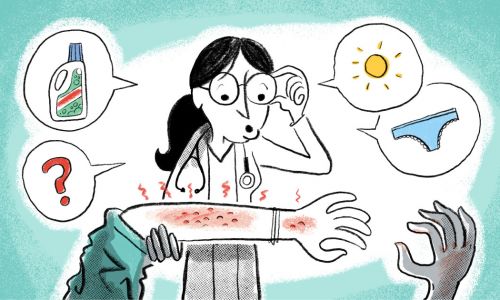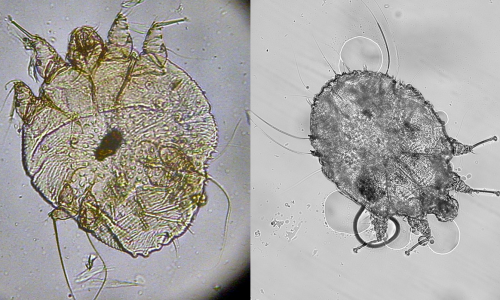Student Eefje wrote a plan to tackle scabies: ‘I laugh now, but only because I cried much before’
-
 Illustratie: Roel Venderbosch
Illustratie: Roel Venderbosch
Scabies can be incredibly uncomfortable, something that student Eefje Janssen experienced for herself. The master’s student suffered the skin condition for no less than ten months. She’s noticed that there is a lot of confusion surrounding scabies, and she’s decided to write down her experiences, in order to help others find treatment.
Wash everything you’ve worn in the past three days at 60 degrees, cover yourself in a special ointment from head to toe -twice-, and avoid any lengthy physical contact with other people: The treatment for scabies is pretty intense, something that many a student can emphasize; the skin condition is currently running rampant among Nijmegen students.
The sheer tenacity of scabies is something that Eefje Janssen (22), master’s student of Spatial Planning, learned the hard way after dealing with the condition for a staggering ten months. To help others find a treatment, she has set up a plan to tackle scabies. ‘I tried to make it a little funny by inserting jokes here and there. I can laugh about it now, but only because I cried so much before.’
Feces and saliva
Scabies is a contagious skin condition, where the scabies mite tunnels into someone’s skin. The mite’s feces and saliva evoke an immune response, leading to bumps and itching. The disease can be caught through lengthy physical contact, or through an infected person’s clothing or furniture upholstery.
Janssen’s ordeal began in February 2022. She developed a mild, itchy skin rash. She returned from a visit to her GP with hay fever medication, which proved unsuccessful. When the itching intensified, the doctor considered that it might be scabies, which resulted in the first of seven (!) scabies treatments that Janssen would undergo.
‘In hindsight, I don’t think I administered the first treatment properly’
Janssen reflects: ‘In hindsight, I don’t think I administered the first treatment properly. I didn’t know where to begin or what to keep in mind.’ Over the course of the treatments, Janssen found out that anything with fabric had to be laundered or stuffed into bags; the scabies mite can survive outside the human body on fabrics and textiles for three days. That includes canvas bags, or a scrunchy kept around the wrist.
‘It’s also important that you don’t skip over any of your housemate’s possessions: everything they -or whoever you share a bed with- have touched, needs to go in the laundry as well.’ To summarise: ‘Consider hand towels, shower curtains, bathroom mats, and carpets. You should also refrain from lending clothes, and you should keep your jackets separate.’
More careful
Janssen is a lot more careful than before, and she is quicker to stop and think before sitting down on an upholstered sofa or letting someone sit down on her own. ‘At one point, I was even afraid to attend lectures, because the lecture halls also have upholstered seating. It made me a little frantic.’
‘People came to me for advice’
In order to prevent other students from running into the same issues, Janssen decided to document her treatment in a step-by-step plan, the so-called scabies plan. The two-page document has been spread around Nijmegen student circles. ‘When more people around me got scabies, they came to me for advice. I’ve put my story and experience in the plan, along with several tips.’
For example: Janssen found that regular application of the anti-scabies ointment can damage the skin, something she put in the scabies plan along with other tips. ‘Of course I hope that others will find those tips useful, but every body responds differently to scabies. Because my skin was very affected by scabies as well as the treatments, I still have regular appointments with my dermatologist.’
Mentally taxing
Scabies not only comes with physical issues; it is also mentally taxing. ‘The treatment itself was not especially tough, but the accompanying stress took its toll.’ For every treatment, Janssen had to consider what to put in bags, what to launder, where she’d been, and whom she might have infected. ‘That was a massive obstacle every single time.’
Additionally, it’s not immediately clear after a treatment if you’re free of scabies: the itching can persist for up to six weeks. Until then, you have to watch where you sit, and especially with whom you share a bed. For the latter issue, Janssen has a nice tip in her plan: ‘Maybe it’s time you and your fling become exclusive’, she says with a wink.
GGD Response
The GGD (public health service, ed.) is very happy with Eefje’s scabies plan; it’s a good way to draw students’ attention to scabies. ‘Discussing it with each other is a good thing, as there is still a taboo surrounding the subject, which is a shame’, according to a spokesperson for GGD Gelderland-Zuid. ‘It’s also important to share your experiences, as this student has done.’
However, the spokesperson doubts whether the GGD would recommend Janssen’s tips on skincare. ‘As she herself states: every body responds differently. And not every tip’s efficacy has been proven. But it is nice to see that she has benefited from it herself.’ The spokesperson emphasises that it’s important not to blindly follow the plan, but rather to keep your own skin in mind and to follow the GGD’s advice.
The GGD has cooperated with the RIVM to setup a step-by-step plan for various scabies treatments, which can be found using this link.
Translated by Jasper Pesch



